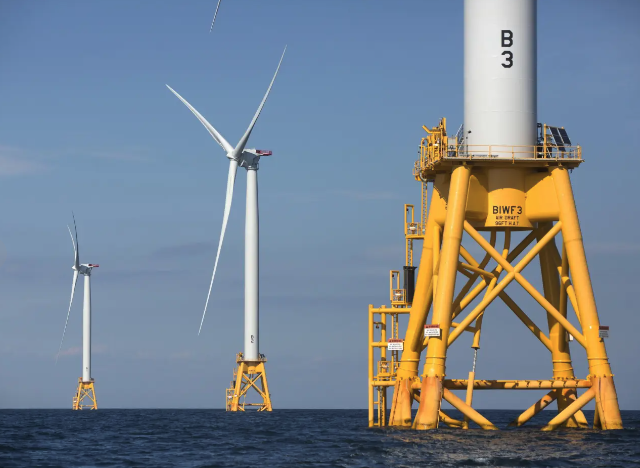Powering the future: La. joins wind energy market
Published 12:47 pm Friday, April 25, 2025

- Three of Deepwater Wind’s five turbines stand in the water off Block Island, R.I., the nation’s first offshore wind farm. (Associated Press Archives)
Louisiana is emerging in the offshore wind energy market, but is facing economic uncertainty following federal actions.
Two Louisiana offshore wind (OSW) developments — Dow LA Gulf Wind and Cajun Wind, LLC — have been secured and are estimated to collectively generate $40 million in lifetime revenue.
The Cajun Wind project alone spans nearly 60,000 acres in offshore Cameron Parish and is projected to generate $29 million. The Dow LA Gulf Wind development will take up 6,162 acres in the Terrebonne and Lafourche parish territories.
These early initiatives are expected to drive economic growth in coastal parishes while also diversifying the state’s energy portfolio.
The Louisiana Department of Energy and Natural Resources (DENR) has taken steps to develop the OSW sector with the Louisiana Offshore Wind Roadmap Advisory Committee. Last year, the committee was formed to create a comprehensive offshore wind energy integration plan.
The committee’s third meeting was in March, where they gave presentations on the national OSW supply chain and updates on the two completed reports: Overview of Louisiana Energy Environment and Overview of Energy Markets.
Ron Norman, senior partner of energy and utilities for PA Consulting Group, is the lead consultant for the energy markets committee workgroup. He said during his update that the energy load-growth across Louisiana is “robust.”
“We’ve got significant industrial power demand, which is often compatible with large-scale power generation projects,” he said.
Additionally, Louisiana touts shallow-water depth, preexisting port infrastructure and an existing trained offshore workforce. Hurdles the state will face range from low wind quality in the Gulf to the need for transmission investments to transport power from the Gulf to power centers.
Offshore wind demand and supply chain
OSW is an industry still in the early stages of development. But the economic benefits are already far-reaching. Sam Salustro, vice president of strategic communication at Oceantic Network — a national organization working to build out the OSW supply chain — discussed the national outlook on OSW.
As of March, about 60 gigawatts (GW) of OSW have been leased by the federal government. These facilities are primarily located on the East Coast, but are also being developed on the West Coast and on the Gulf Coast.
Nationally, there is one complete OSW project and five in active installation. Just these few projects have resulted in $25.5 billion in investments — ports, vessels, factories — for the OSW supply chain that spans 40 states.
The demand for OSW has been driven by the states through utility or state-mandated OSW procurement policies, with several states passing amendments, proposals and initiatives to prioritize alternative energy sources, resulting in a demand of 116 GW.
“While the federal government is generally the supply lever of the market, the states are the demand lever,” he said.
This trend is close to home. Last November, Louisiana voters passed an amendment to dedicate any future federal funds the state receives from offshore alternative energy production to the Coastal Protection and Restoration Fund, a constitutionally protected fund for coastal protection projects and programs.
This aligns with a nationally trending preference for renewable energy. This marketwide demand for clean energy has originated from the private sector by consumer preferences, improved technology, tax incentives, declining capital costs and clean energy standards, Norman said.
States are driving this market forward to address energy demand issues. With the rise of data centers — networked computer servers that are used for remote storage, processing and data distribution — that are expected to eat up to 11.7 percent of U.S. power in 2030, states are looking to secure alternative energy sources quickly. The United States will need 50 percent more power production by 2035.
These projections have created a “tailwind” for clean energy discussions.
“There’s a real rush to figure out how to meet this demand. … There’s always this underlying preference from the data center owners and developers for clean energy,” he said.
Salustro called it a “conversation about how to fill the looming energy gaps and the fact is that offshore wind is, frankly, a shovel-ready industry at this point.”
He continued by explaining that OSW is desirable because it has high capacity, and consequently, a “strong and reliable grid” that is “essentially as close to a base-level power source as we’re going to get in renewable energy” — factors that are compatible with high-load facilities like data centers.
Additionally, OSW results in fuel and ratepayer bill savings, he said.
The national expansion of OSW is dependent on the Gulf states’ industry expertise.
“Up in the Northeast, they just do not have the expertise to build this industry.”
Twenty-four percent of the OSW supply chain, or about 500 contracts, are from the South and Gulf Coast — Alabama, Florida, Louisiana, Mississippi and Texas. Oceanic has tracked $2 billion in regional investments to support the supply chain, primarily in Gulf shipyards and steel fabrication; Louisiana has three shipyards and two steel fabrication and supply facilities.
Andy Logan, head of operations and people at Xdous Group and lead consultant for the supply chain and workforce committee workgroup, said that while there are over 120 companies in the Louisiana Offshore Wind Supplier Database, recent studies have found that this could increase to over 450.
OSW also bolsters local workforces by creating new construction and operations jobs. Oceantic reported that Vineyard Wind 1, an OFW facility in Massachusetts, created about 2,800 construction jobs (about half of which were local) and 80-plus long-term operations jobs.
The Overview of Louisiana Energy Environment study also determined that there are currently 60,000 Louisiana workers employed in industries adjacent to offshore wind.
“There are hundreds of companies and thousands of workers who stand to benefit from the expansion of the offshore energy industry,” Logan said.
Federal action
Despite national interest, the trajectory of OSW could be stunted at the federal level.
On his first day in office, President Donald Trump signed an executive order to temporarily halt offshore wind lease sales and pause the issuance of permits for onshore and offshore wind projects in federal waters to assess the wind leasing and permitting practices.
These federal actions against OSW have continued throughout the first months of his term. The Associated Press reported this month that his administration revoked a Clean Air Permit for an offshore wind project off the coast of New Jersey in March; On April 16, he ordered that the construction of the New York OSW project, Empire Wind, be stopped.
The executive actions regarding OSW are points of concern for the industry, Salustro said. Projects to produce about 30,000 GW of energy have been mapped out to 2033. The supply chain has been built out to meet an accelerating and nationally supported industry, but the pause on permits could lead to a “loss of economic potential.”
“That threatens to strand assets that have been built both down in Louisiana and up in the Northwest to support the industry,” he explained. “The loss of business pipeline is impacting states like Louisiana, Texas, just as much as its impacting Massachusetts and New York.”
Louisiana’s state-leased projects will not be directly affected by the federal permitting freeze, but projects could face challenges.
Public information and meeting recordings are available on louisianaoffshorewind.org.
“Clearly, that creates a headwind not just for the development of offshore wind off the coast of Louisiana, but for projects across the US,” Norman added later. “Therefore, the supply chain as it may integrate with Louisiana and other regions, is complicated by the slowdown the industry is facing.”





